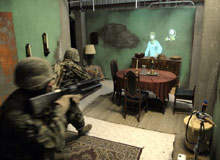
Engaging in urban combat where elements of the indigenous population are hostile to outside forces, is extremely difficult. When under extreme pressure, new and experienced infantryman alike can make errors of judgement with deadly results to the civilian population. But, in California there is now a new form of scenario urban training designed around lessons learned in the field which could make a vital difference to both the soldiers and the innocent civilians that are so often caught up in the middle of a conflict.
Camp Pendleton near San Diego, California, is the base for the first Marine Expeditionary Force (I MEF). Here, in the unlikely setting of a 32,000ft² former tomato packing plant, next-generation infantry training is underway with both experienced and trainee marines of I MEF.
After ten years of designing the concept and then its creation by the Office of Naval Research (ONR), the infantry immersion trainer (IIT), was officially unveiled in January 2008. In reality, IIT is a heady mixture of Hollywood-like sets representing a typical Iraq scenario, real people playing various roles, pyrotechnics and computer-generated simulations.
Not taking into account the technological elements in the development of ITT, ONR estimates that the Camp Pendleton facility cost around $2.5m.
Dr Roy Stripling is the project manager of IIT and says that the facility was so long in coming because of the sheer scale of the research behind it. “The desire came first from folks out of I MEF, specifically from their training and experimentation group. They wanted us to build a demonstration unit or a prototype showing the possible capabilities.” He adds: “From the time that we got the money to do this particular job to the time where marines were walking through it, probably took two to three months. But it was built on about ten years of research.”
IIT is designed for marine training. However, some of the technology was developed by the US Army Research Development & Engineering Command (US Army RDE COM) largely through RDE COM’s Institute for Creative Technology at the University of Southern California. Others contributing to the project included Strategic Operations, which provided set development services and pyrotechnics and other simulated elements, Lockheed Martin and NAVAIR Orlando that provided simulation work and, not surprisingly given the nature of IIT, a company called Game Production Services, a specialist in simulation environments for the military.
Live environment
Every thought has gone into making the facility as realistic as possible. “There are live role players in the environment and they take on the roles of civilians, potential adversaries or innocent bystanders and the trainees can interact with them,” says Stripling. “There’re a lot of other elements like pyrotechnics and other simulated technology and there’s also the actual simulation software. In several of the rooms there is projection technology that actually projects computer generated avatars.”
Marine trainees use military paintballs and have a low-powered laser fitted to their weapons that is discharged each time a marine pulls the trigger. “It really only matters in the room with the computer generated avatars because there are cameras in those rooms that detect where they are shooting based on where the laser is. That’s how the avatar knows whether it has been hit or not,” he says.
Not only can ITT provide more effective, realistic training but safety issues are addressed too, although with some limitations to realism. Stripling says that although it is largely a hazard-free environment, the paintballs can still cause some damage. “They can actually break skin and the trainees have to wear safety masks. That limits the realism to the extent that it has some impact on their ability to communicate directly with each other and with the live role players.”
IIT is capable of future upgrades and the insertion of different scenarios for new missions as and when the situation arises. The software element is government owned and so has been designed with the development of different scenarios in mind. But it is always possible to add new characters, change their role and alter the way they react to different situations very easily. “With the live role playing part it’s just a matter of finding people who can play those roles,” says Stripling.
Army simulations
He also explained that the marine IIT is not the first such programme in the US for infantry training as the army already has a couple of programmes along the same lines. “We were leveraging army technology when we built this, over that same ten-year period.”
The US army has both walk-through environments and pure simulation training facilities. Although tactics of the different forces may vary, the environment which both units need to train in is actually very similar.
The proof of the pudding however, is in the eating. Chairman, Joint Chiefs of Staff, Admiral Mike Mullen, says: “It’s a reminder of what simulation can do. It certainly is great preparation for the marines as they prepare to go to Iraq. Very impressive, very realistic and in the end hopefully, we’ll contribute significantly to a better way to execute the mission and save lives.”
And, from an everyday user point of view, Sgt. William Jones, Officer in Charge, IIT is upbeat too. “Every comment we get from the marines that come through is positive. Both the senior marines that have been on tour and the marines that haven’t been to Iraq yet say that this is the best thing they’ve ever seen,” said Jones.
Now, beyond the boundaries of Camp Pendleton, Stripling says that similar facilities are already in the works. “We’ve built a small facility that hasn’t had its official opening yet,” he says, referring to a construction in Quantico that will be for testing infantry equipment rather than infantry training. A further training facility matching Camp Pendleton’s is already on the drawing board in Camp Lejeune for the Second Marine Expeditionary Force (II MEF).




